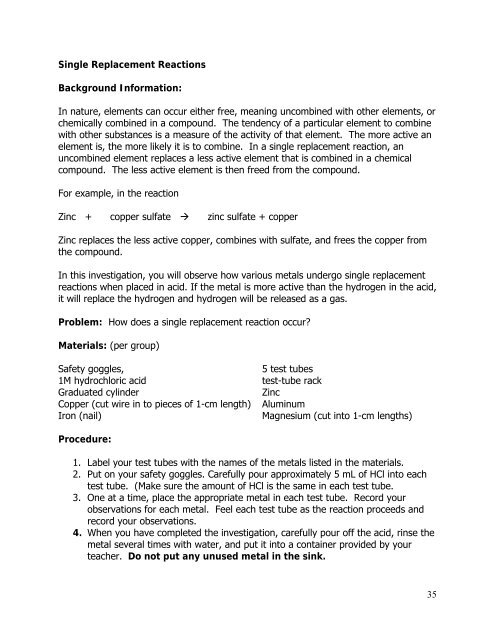Nomenclature and Chemical Reactions - Oakland Schools
Nomenclature and Chemical Reactions - Oakland Schools
Nomenclature and Chemical Reactions - Oakland Schools
Create successful ePaper yourself
Turn your PDF publications into a flip-book with our unique Google optimized e-Paper software.
Single Replacement <strong>Reactions</strong><br />
Background Information:<br />
In nature, elements can occur either free, meaning uncombined with other elements, or<br />
chemically combined in a compound. The tendency of a particular element to combine<br />
with other substances is a measure of the activity of that element. The more active an<br />
element is, the more likely it is to combine. In a single replacement reaction, an<br />
uncombined element replaces a less active element that is combined in a chemical<br />
compound. The less active element is then freed from the compound.<br />
For example, in the reaction<br />
Zinc + copper sulfate zinc sulfate + copper<br />
Zinc replaces the less active copper, combines with sulfate, <strong>and</strong> frees the copper from<br />
the compound.<br />
In this investigation, you will observe how various metals undergo single replacement<br />
reactions when placed in acid. If the metal is more active than the hydrogen in the acid,<br />
it will replace the hydrogen <strong>and</strong> hydrogen will be released as a gas.<br />
Problem: How does a single replacement reaction occur?<br />
Materials: (per group)<br />
Safety goggles,<br />
1M hydrochloric acid<br />
Graduated cylinder<br />
Copper (cut wire in to pieces of 1-cm length)<br />
Iron (nail)<br />
5 test tubes<br />
test-tube rack<br />
Zinc<br />
Aluminum<br />
Magnesium (cut into 1-cm lengths)<br />
Procedure:<br />
1. Label your test tubes with the names of the metals listed in the materials.<br />
2. Put on your safety goggles. Carefully pour approximately 5 mL of HCl into each<br />
test tube. (Make sure the amount of HCl is the same in each test tube.<br />
3. One at a time, place the appropriate metal in each test tube. Record your<br />
observations for each metal. Feel each test tube as the reaction proceeds <strong>and</strong><br />
record your observations.<br />
4. When you have completed the investigation, carefully pour off the acid, rinse the<br />
metal several times with water, <strong>and</strong> put it into a container provided by your<br />
teacher. Do not put any unused metal in the sink.<br />
35
















